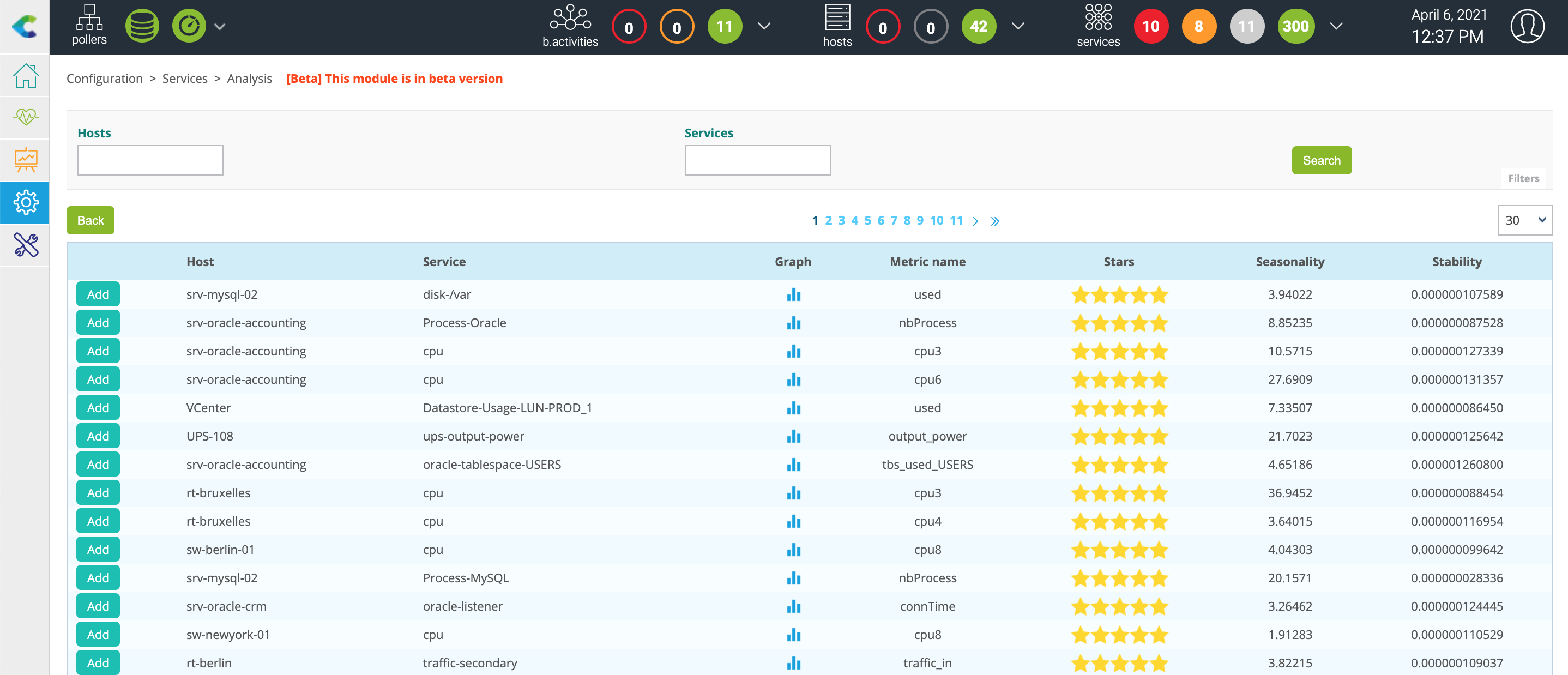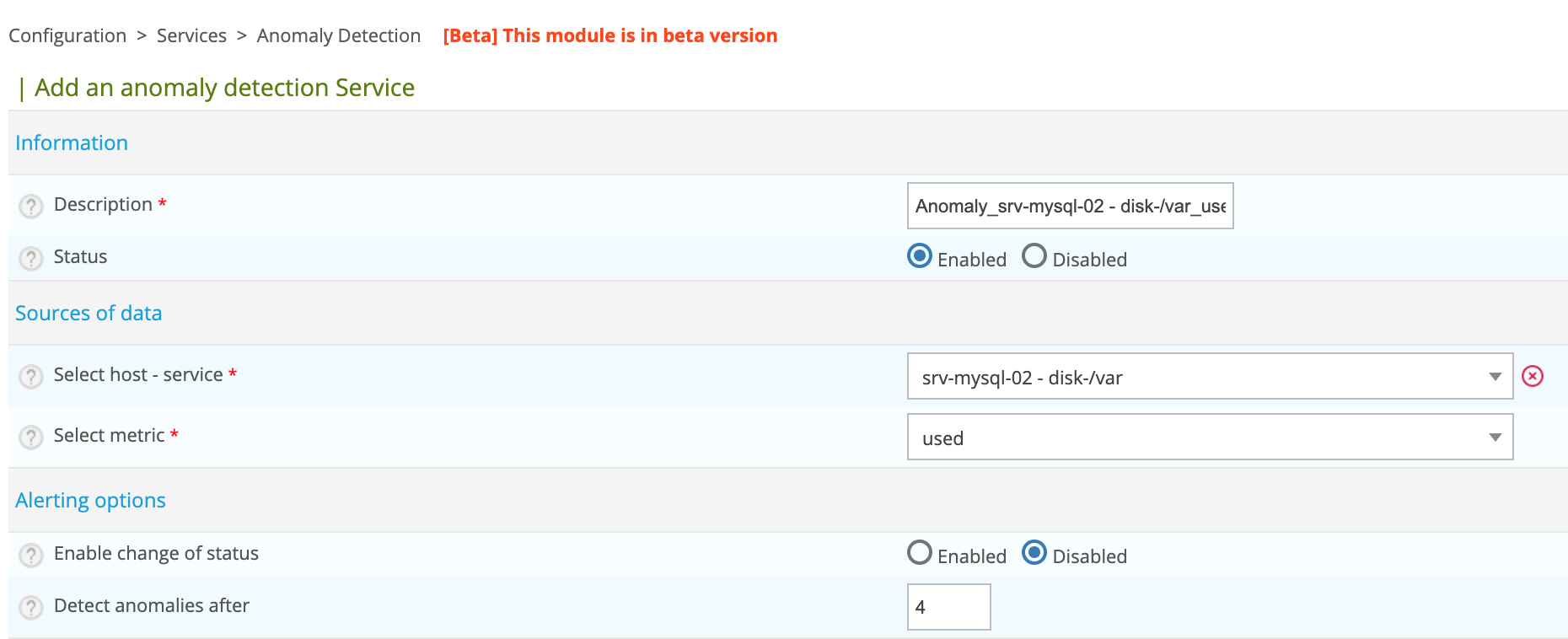Anomaly detection
In Centreon Cloud, only users with the Administrator or Editor role can configure an Anomaly Detection service.
Description
The Centreon Anomaly Detection module detects deviations from the regular behavior of a service. It uses dynamic thresholds to trigger alerts.
With "classic" monitoring, alerts are triggered from static thresholds. For instance, users are alerted when the ping on a server exceeds 700 ms. However, for some services, "normal" values change over time, which means that static thresholds are not that relevant. You can use Anomaly Detection when the behavior of a service is repetitive and predictable:

Anomaly Detection determines how the normal values evolve over time; predictions calculate a lower threshold and an upper threshold. When the behavior of the service deviates from the expected model, these thresholds are passed (i.e. the metric goes below the lower threshold or goes over the upper threshold). The service goes into a CRITICAL state and a notification is sent. Example: a server usually has little traffic at night. One night, Centreon detects network flows that are higher than normal and triggers an alert. This makes the company aware that the server has been hacked.
How it works
-
Collected data is sent to the Centreon SaaS platform.
-
Centreon computes a regular behavior model using the history of this data.
-
Once the model has been calculated, predictions are then generated and retrieved by your Centreon platform.
-
The predictions act as floating thresholds, which will then be used by the monitoring engine to compare the collected value with the predicted thresholds to highlight deviations and generate alerts. Data received during downtimes is not taken into account when computing predictions, to avoid distorting the analysis.
-
Models are recomputed regularly and improve over time.
Add your token
-
Retrieve your token from your organization's page in the CIAM.
-
Go to Configuration > Services > Anomaly Detection and click Add Centreon Cloud Token.
-
Enter your token and click Save.
Your Centreon platform is now ready to use Centreon Anomaly Detection.
Configuration
To have a fully functional Anomaly Detection service, you need to complete four steps:
- Create an Anomaly Detection service. This will activate the sending of the collected data to the Centreon SaaS platform, in order to start modeling regular behavior.
- Assess the relevance of the computed predictions.
- Once the model seems right, activate status changes for the service.
- When all changes in status seem relevant, activate the notification process.
Step 1: Create an Anomaly Detection service
You can create an Anomaly Detection service manually, or use the creation wizard. To create an Anomaly Detection service manually:
-
Go to Configuration > Services > Anomaly Detection and click Create manually:
-
Fill in the following fields:
- Description: the name of the service. The following characters are not authorized:
~!$%^&|'"<>?,()=*{}and spaces. - Status: enable or disable the service. If you disable the service, after you deploy the configuration, the service will no longer be monitored (for instance, it will no longer appear on the Resources Status page ).
- Select host - service: choose the host/service pair on which the Anomaly Detection service will be based.
- Select metric: select the metric on which to apply anomaly detection.
- For the time being, leave the Enable change of status and Enable notifications fields set to Disabled (they will be enabled in Steps 3 and 4).
- In the Categories and groups section, you can set a severity level.
-
Click Save.
-
-
The service appears on the Monitoring > Resources Status page. To display only Anomaly Detection services, use the Type filter in the Filter options window.
-
The behavior model calculation starts. However, until calculations have been made and predictions sent to your platform, the status of the service is UNKNOWN. For predictions to be computed, you need to have at least 4 hours' worth of data.
-
The first predictions will appear in up to 36 hours. The service will then be in an OK status, until status changes are enabled (Step 3).
-
Step 2: Assess the relevance of the predictions
At first, the predictions you receive will not be very relevant: Anomaly Detection needs to identify several repetitions of data patterns before it can compute a correct model. This means that the length of time needed to compute the model varies according to how often your data repeats (daily, weekly, etc.). In general, you will need to wait for about 6 weeks to obtain a stable model.
To assess the relevance of the predictions, look at the service's graph on the Monitoring > Performances > Graphs page, or on the Graphs tab of the details panel, find the service on the Monitoring > Resources Status page.
You can manually adjust the distance between the curve and the thresholds, if you think this is necessary (e.g if you see too many false positives, or on the contrary if the predictions do not detect enough incidents).
- On the Monitoring > Resources Status page, click the Anomaly Detection service you want, and then click the Graph tab in the details panel.
- Click the Edit anomaly detection data icon (wrench) at the top right of the tab. The graph opens in a pop-up window.
- Use the slider in the Manage envelope size section to change the range of the predictions. In the preview, checks outside the envelope are shown by red dots.
- Click Save. The new envelope size is applied from that moment on. The envelope that was already calculated stays the same (this means that the changes are not visible immediately on the graph).
Step 3: Activate status changes
If, by regularly checking the generated model and the data from the Monitoring > Performances > Graphs menu, you think that your model is stable, you can activate status changes. Once you enable this option, the status of the service will switch to CRITICAL SOFT as soon as the metric goes below the lower threshold or above the upper threshold.
-
Go to the Configuration > Services > Anomaly Detection menu and click the Anomaly Detection service you want.
-
In the Alerting options section, enable the Enable change of status option.
-
In the Detect anomalies after field, enter the number of deviations before the service switches to a CRITICAL HARD state. (When enabled, notifications are only sent when the service switches from SOFT to HARD.)
-
Click Save.
Step 4: Activate the notification process
Notifications on Anomaly Detection services are configured in the same way as notifications for regular services.
Use the creation wizard
The creation wizard lets you highlight the services that follow patterns or have a regular stability (for which values are consistently included between two thresholds).
Go to Configuration > Services > Anomaly Detection and click Create from analysis.
The list of existing services on your Centreon platform is displayed, as well as a score in number of stars: from 5 stars to 0, 5 stars representing high potential services:

After selecting a service of interest, click the ADD button to the left of the row. You arrive on the pre-filled creation form:

Modify the name of the service and then click the Save button.
If the list is empty, it means that the calculation to determine which services are of interest has not yet started. This is done every six hours.
View the anomalies detected
Once you have created an Anomaly Detection service, you can see it in the following places:
- The Monitoring > Resources Status menu.
- The Monitoring > Performances > Graphs menu.
- The Monitoring > Event Logs > Event Logs menu.
- The service-monitoring widget in the Home > Custom Views menu.
- You can use an Anomaly Detection service as an indicator in Centreon BAM.
- And all menus where you can operate on services.
FAQ
How long is the data stored?
The data is kept for the entire validity of the license. This will allow the recalculation of models if necessary. An additional period of 3 months will be added at the end of the validity of the license before deletion.
What data is hosted by the service?
The data hosted by the anomaly detection service only concerns data linked to the services created by the user. It includes the date and time of the check, the identifier of the monitored resource, the identifier of the associated indicator, the name of the performance data on which the computations will be performed, and the value of the performance data.
How is the sending and storage of my data protected?
Sending data to our Cloud infrastructure is risk-free. Data is sent using end-to-end encryption. Collected data consists only in metrics and some Centreon identifiers (host name, service name). Our environment is protected by AWS Web Application Firewall and AWS Shields to prevent DDoS attacks. Our architecture has been reviewed by AWS architects (AWS Foundational Technical Review) and we are an AWS Qualified Partner.
What is the data used for?
The data is used to compute behavior models. These models will generate predictions used as floating thresholds by the Centreon platform.
Who has access to the data hosted by the service?
The data is associated with the access token of the anomaly detection offer. It is hosted on the Centreon SaaS Platform and partitioned by platform. Users with a token can only access their own data.
How can I request the deletion of data?
The deletion of data may be requested at any time. However, the history of the data is used to create a model to calculate the floating thresholds. Therefore, participation in the program or subscription to the subsequent offer will be impossible. A request must be made via the Centreon professional support interface.